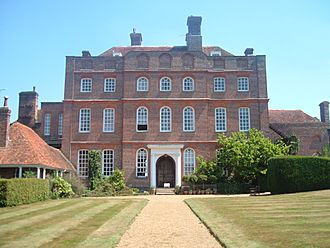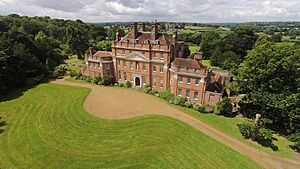Finchcocks facts for kids
Quick facts for kids Finchcocks |
|
|---|---|

View of the rear of the house, from the garden
|
|
| General information | |
| Type | House |
| Architectural style | Georgian |
| Classification | Grade I listed |
| Address | Finchcocks |
| Town or city | Goudhurst, Kent |
| Country | United Kingdom |
| Coordinates | 51°06′08″N 0°25′38″E / 51.1022°N 0.4273°E |
| Completed | 1725 |
| Technical details | |
| Floor area | 15,387 square feet (1,429.5 m2) |
|
Listed Building – Grade I
|
|
| Designated | 9 June 1952 |
| Reference no. | 1318935 |
| TQ 7003 3646 | |
Finchcocks is a beautiful old house in Goudhurst, Kent, England. It was built a long time ago in 1725. For many years, it was home to a special museum. This museum had a huge collection of old musical instruments, especially keyboard instruments like harpsichords and fortepianos.
The museum was run by Richard and Katrina Burnett until 2017. Now, Finchcocks is owned by Neil and Harriet Nichols. They live there with their family. They also use the house to host piano courses and classical music concerts. It's a place where music continues to be a big part of its story!
Contents
Who Lived at Finchcocks?
This grand house was built in 1725. It got its name from a family who lived on the land way back in the 1200s.
One early owner was Edward Horden. His family symbol is carved above the front door. Edward was a special secretary to the royal family. He helped organize royal trips and managed the money for the Royal Household. He worked for three different monarchs: Edward VI, Mary, and Elizabeth I.
The house you see today was built for Edward Bathurst. He was a lawyer from London. Edward lived at Finchcocks until he passed away. After him, his son Charles and then his brother Thomas owned the house.
Later, in 1797, Robert Springett bought Finchcocks. He was a local landowner who made the estate much bigger. In 1863, his family sold it to Edward Hussey, who lived nearby at Scotney Castle.
During Edward Hussey's time, a famous writer named Siegfried Sassoon visited Finchcocks. He even wrote about the house in his memories.
During the Second World War, students and teachers from Kings School Rochester stayed there. After that, the army used the house for a while.
From 1960 to 1970, Finchcocks became a ballet school. It was run by Nicolas Legat and his wife, Nadine Nicolava Legat. They were famous for bringing classical Russian ballet to the UK.
In 1971, Richard and Katrina Burnett bought the house. They carefully fixed it up. In 1976, they opened it as a museum for their amazing collection of old keyboard instruments. It also became a place for concerts.
When the Burnetts retired in 2015, the museum closed. Many of their instruments were sold to other collectors. Finchcocks was then bought by Neil and Harriet Nichols. They are also musicians and continue the musical tradition. They offer piano courses and host concerts, making it their family home.
The House's Design
Finchcocks is known for its beautiful brickwork. The front of the house looks very grand. Some people think it was designed by a famous architect named Thomas Archer. The house sits on about 25 acres of land.
In front of the house, there's a large park. Behind it, there's a lovely garden with wide green lawns and pretty flower beds. There's also an area for wild flowers and a special walled garden. Around the house, there's a hidden ditch called a "Ha Ha." This ditch keeps animals out without blocking the view. From the house, you can see amazing views of the Kent countryside, with farms and hop-gardens.
The main part of the house is long and rectangular. It has curved sections on the sides, which is a style called English Baroque. The front has fancy decorations and pillars. The back of the house is simpler. Inside, the cellar (basement) was built so grandly that it actually delayed building other parts of the house! The main building has four floors above the cellar. A central hallway runs through the middle of the house.
Finchcocks shares some design ideas with other nearby houses. These include Matfield House and other buildings known to be designed by Thomas Archer.
Music and Media at Finchcocks
The rooms inside Finchcocks have high ceilings and oak wood panels. This made them perfect for playing music on old instruments. Many famous musicians who play early music recorded their performances here. Some of these musicians include Trevor Pinnock and Simon Preston.
Finchcocks has also been featured on TV and radio. It appeared on BBC Radio 3 and in music magazines. It was even used as a filming location for the movie The Amazing Mr Blunden, directed by Mark Gatiss.
The Finchcocks Instrument Collection
Richard Burnett, a talented fortepianist, bought Finchcocks in 1970. He and Derek Adlam set up a workshop there. This workshop helped instrument makers learn how to build copies of old keyboard instruments. They could study the original instruments right there in the house.
The house became home to the Katrina and Richard Burnett collection. It had over 100 historical keyboard instruments! About 40 of them were fully repaired and could be played. Visitors could see and even play these instruments. It was one of the few places where people could actually touch and play such old instruments.
When the Burnetts retired in 2015, the museum closed. Many of the instruments were sold at an auction to raise money for charity. The auction was very successful, and the instruments sold for much more than expected.
However, fourteen special instruments from the collection were kept. They are now part of the Richard Burnett Heritage Collection. They are housed at the Burnetts' home in Tunbridge Wells.
Finchcocks also had a collection of musical pictures and prints. There was even an exhibition about London's fun pleasure gardens from the 1700s, like Vauxhall and Ranelagh Gardens.
Images for kids




